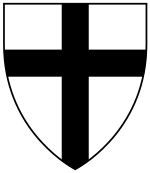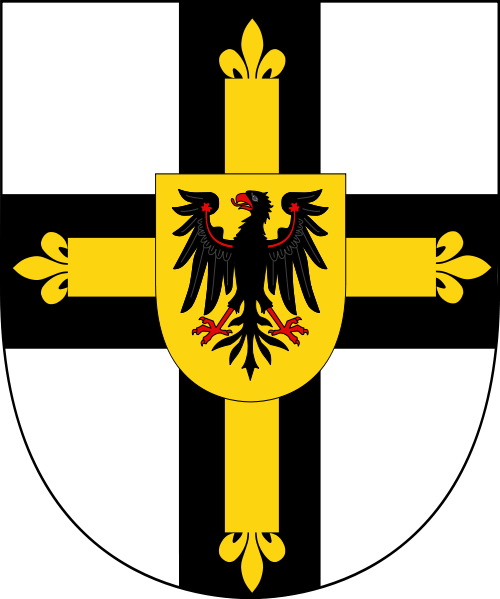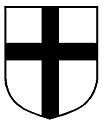|
|
 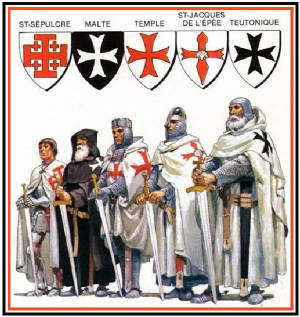 
Religious Military Orders - Militaris Ordinis A religious military order
(Latin: militaris ordinis) is a Christian religious society of knights.
The original military orders were the Knights Templar, the Knights Hospitaller and the Teutonic
Knights. They arose in the Middle Ages in association with the Crusades, their members being dedicated to the protection
of pilgrims and the defence of the Crusader states. They are the predecessors of the secular
chivalric orders. Most members of military orders were laymen who took religious vows, such
as of poverty, chastity, and obedience, according to monastic
ideals. The orders owned houses called commanderies all across Europe and had a hierarchical
structure of leadership with the grand master at the top. The Knights Templar, the largest and most influential of the military
orders, was suppressed in the early fourteenth century; only a handful of orders were established and recognized afterwards.
However, some persisted longer in their original functions, such as the Sovereign Military Order of Malta and the Order of
Saint John, the respective Catholic and Reformed successors of the Knights Hospitaller. Those military orders that survive
today have evolved into purely honorific or ceremonial orders or else into charitable foundations. 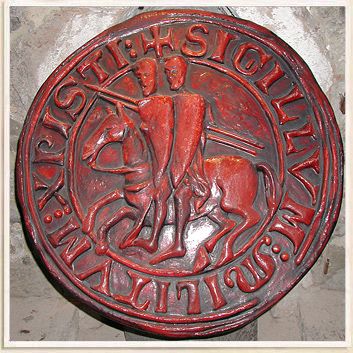
History In 1053, for the Battle of Civitate, the Knights of Saint Peter (Milites Sancti
Petri) was founded as a militia by Pope Leo IX to counter the Normans. In response to the Islamic
conquests of the former Byzantine Empire, numerous Catholic military orders were set up following the First Crusade.
The founding of such orders suited the Catholic church's plan of channeling the devotion of the European
nobility toward achieving the Church's temporal goals, and it also complemented the Peace and Truce of God. The foundation
of the Knights Templar in 1118 provided the first in a series of tightly organized military forces for the purpose of opposing
Islamic conquests in the Holy Land and in the Iberian Peninsula — see the Reconquista
— as well as Islamic invaders and pagan tribes in Eastern Europe which were perceived
as threats to the Church's supremacy. The first secularized military order
was the Order of Saint George, founded in 1326 by King Charles I of Hungary, through which he made all the Hungarian nobility
swear loyalty to him. Shortly thereafter, the Order of the "Knights of the Band"
was founded in 1332 by King Alfonso XI of Castile. Both orders existed only for about a century. 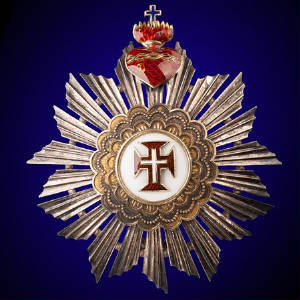 Purpose The original features of the military orders were the combination
of religious and military ways of life. Some of them, like the Knights Hospitaller and the Knights of Saint Thomas, also had
charitable purposes and cared for the sick and poor. However, they were not purely male institutions, as nuns
could attach themselves as convents of the orders. One significant feature of the military
orders was that clerical brothers could be subordinate to non-ordained brethren. In 1818,
the orientalist Joseph von Hammer compared the Catholic military orders, in particular the
Knights Templar, to certain Islamic models such as the Muslim sect of Assassins. In 1820,
José Antonio Conde suggested they were modeled on the ribat, a fortified religious institution which brought together
a religious or hospital way of life with fighting the enemies of Islam. However popular such views may have become, others
have criticized this view, suggesting there were no such ribats around Outremer until after the military orders had been
founded. The role and function of the military orders extended beyond their military exploits in the Holy Land, Prussia,
and the Baltics. In fact, they had extensive holdings and staff throughout Western Europe.
The majority were laymen. They provided a conduit for cultural and technical innovation,
such as the introduction of fulling into England by the Knights Hospitaller, and the banking facilities of the Knights Templar.
 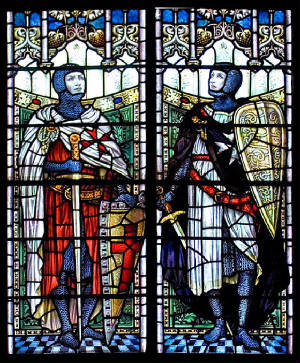 
The List of Religious
Military Orders These are military
orders listed chronologically according to their dates of foundation and extinction, sometimes approximate due to scarce
sources, and/or repeated suppressions by Papal or royal authorities. Presently active institutions are listed in consideration
with their legitimacy according to the International Commission on Orders of Chivalry. They are divided into international
and national according to their adherence, mission, and enrollment, disregarding the extent of eventual gradual geographical
distribution outside of their region of concern. International
 | Order of the Holy Sepulchre
(Militi Sancti Sepulcri)
| c.1099
1103 | Godfrey of Bouillon
| Jerusalem, Latin
Kingdom of Jerusalem | 1103 by Baldwin I of Jerusalem
1113 by Pope Paschal II | Kingdom of Jerusalem to 1291,
Custos of the Holy Land: 1230-1489,
Pope: 1489- |
| Originally an "association" of knights
who guarded the Church of the Holy Sepulchre under the jurisdiction of the kings of Jerusalem. In 1113, they became consubstantial
with the Canons of the Holy Sepulchre after their recognition by Pope Paschal II, as a military
branch, Militi Sancti Sepulcri; after 1291, the Knighthood was awarded to prominent pilgrims by the Custos
of the Holy Land. Reorganised as Sacred and Military Order of the Holy Sepulchre in 1496 by Pope Alexander
VI. Reorganised by Pope Pius IX with the residential restoration of the Latin Patriarchate of Jerusalem in 1847.[6]
Known as the Equestrian Order of the Holy Sepulchre of Jerusalem since 1931. |  | Knights Hospitaller
(Sovereign Military Order
of Malta and the Order of Saint John) | c.1099
1113 | Gerard Thom |
Jerusalem, Latin Kingdom of Jerusalem
| 1113 by Pope Paschal II | Grand Master (1113-),
Prince (1607-),
Cardinal (1630-) |
| Officially
it still remains a Christian order, with a Catholic successor, the Sovereign Military Order of Malta, and a Protestant successor,
the Order of Saint John, both of whom mutually recognise one another.
Regional connections are also claimed by Freemason
bodies. |  | Knights Templar
(Supreme Order of Christ)
(Order Of Christ) | c.1118 | Bernard of Clairvaux,
Hugues de Payens | Jerusalem, Latin Kingdom of Jerusalem | 1129 by Pope Honorius II
until 1312 by Pope Clement V | Pope:
1129-1312 | 1312 | The Knights Templar order was reconstituted in Portugal after the Templars were abolished on 22 March 1312 by the
papal bull,Vox in excelso, issued by Pope Clement V. King Dinis I of Portugal created
the Order of Christ (Portugal) in 1317 for those knights who survived their trials throughout Europe and was officially founded
in 1319, The property of the Templars was transferred to the Knights Hospitaller except in the Kingdoms of Castile, Aragon,
and Portugal. In effect, causing the dissolution of the Templars by the rival order. Thus when being recognized, the Pope allowing only the "Order Of Christ" a Portuguese order and its Papal
branch Supreme Order of Christ can claim to have any descent from the Templars, which is now used for Honorary State merits
in Portugal and preserved as such. |  | Order of Saint Lazarus
(Order of Saints Maurice
and Lazarus) | c.1118 |
| Jerusalem, Latin Kingdom
of Jerusalem | 1255 by Pope Alexander IV
until 1489
by Pope Innocent VIII | King Fulk of
Jerusalem: 1142
Pope: circa 1255-1572
House of Savoy: 1572-
House of France: 1609-1830, 2004- |
1489,
1572,
1609,
1830
(1856) | Italian branch merged 1572 with the Order of Saint Maurice to
form the Order of Saints Maurice and Lazarus under the Royal House of Savoy, still extant. In 1609, King Henry IV of France linked it in France administratively to the Order of Our Lady of Mount Carmel to
form the Royal Military and Hospitaller Order of Our Lady of Mount Carmel and Saint Lazarus of Jerusalem united, which remained
listed as of royal protection in the French Royal Almanac until 1830. Royal protection of the Royal house of France renewed
2004. |  | Teutonic Knights
| 1190 |
| Acre,
Latin Kingdom of Jerusalem
|
|
|
| The main stem of the Teutonic Knights converted into a purely Catholic religious order
in 1929 and then in 2001 the Teutonic Order of Saint Marys Hospital in
Jerusalem - Deutscher Orden - German Order was formally revived back into a Chivalric Order of Knighthood, thus
making a separate Chivalric Arm of the Teutonic Order from the present Clerical Papal Arm of the Order in Rome,
By His Imperial and Royal Highness Prince Karl Friedrich of Germany, on Christmas Day in the year of Our Lord Two
Thousand and One, by Imperial Decree. His Imperial Highness, assumed the Grand Mastership of the Teutonic Order -
Deutscher Orden, on the 1st day of Janaury, 2002, thus becoming the 60th Chivalric Hoch-und-Deutschmeister of Teutonic
Order of Saint Marys Hospital in Jerusalem - Deutscher Orden. The
Bailiwick of Utrecht of the Teutonic Order separated from the Roman Catholic mainstem during
the time of the Reformation and continues as a Protestant chivalric order. | National
 | Order of Saint James of Altopascio | 1075
(1084) | Matilda
of Tuscany | Altopascio, Tuscany, Holy Roman Empire |
1239-1459,
but mentioned in a Papal bull 1198 of Pope Innocent
III | Properties of the hospice of "Altopassus"
in Italy confirmed in 1244 by Emperor Frederick II | 1459,
1587,
1672 | Primarily
provided safety and protection to Italian pilgrims to the Holy Land and Camino de Santiago. Merged with the Order of Saint
Stephen in 1587 by Pope Sixtus V at request of Grand Duke of Tuscany. In France absorbed
into the Order of Saint Lazarus in 1672. |  | Order of Aviz | 1146
(1128) |
| Avis, Portugal |
|
Received a grant in 1129 by Theresa, Countess of Portugal
House of Aviz:
1385-1580 | 1789 | Secularised 1789. Statutes revised repeatedly together with the other Portuguese orders of merit, during the First
Republic (1910–1926), then in 1962, and again in 1986. |  | Order of Saint Michael of the Wing | 1147
(1171)
(1828/
1848/
1986) | King Afonso I of Portugal | Santarém,
Portugal | First statutes approved in 1171 by Pope Alexander III
| House of Braganza: 2001- | 1732 | Abandoned by 1732, restored by King
Miguel I in 1828 during his brief rule before losing the Liberal Wars to his brother King Pedro IV, revived 1848/1986
|  | Order of Calatrava | 1158 | Raymond of Fitero |
Calatrava la Vieja, Kingdom of Castile, Spain | 1164 by Pope Alexander III | House of
Bourbon | 1838 by secularisation | King Charles III of Spain requested old orders to contribute to his new order in his name (1775),
which led to dissolution. Confiscated by King Joseph (1808), re-established by Ferdinand VII
at the Restoration (1814). Secularised in 1838. |  | Order of the Holy Ghost | 1161 | Guy de Montpellier
| Provence, France | ca. 1161–June 16, 1216 by Pope Innocent III in Santo Spirito in Sassia, Rome |
| 1692/
1700/
20th century
| Historically both religious and chivalric. In 1692 in France,
King Louis XIV merged it with his own Order of Our Lady of Mount Carmel. The remaining organisation
was edicted in 1700 as purely religious order. Offshoots of the order in France survived into the 20th century. |
 | Order of Aubrac | 1162 |
| Aubrac, France |
|
| 18th century | Disappeared during the French Revolution in late in the 18th century. |
 | Order of Santiago | 1170 |
| León or Uclés in Castile, Spain | By Papal bull 5 July 1175 by Pope Alexander III | House of Bourbon |
|
|  | Order of Alcántara | 1177 |
| Alcántara, Extremadura, Spain |
|
|
|
|  | Order of Mountjoy | 1180 |
| Holy Land |
|
| 1221 | Merged into the Order of Calatrava. |
| Order of Truxillo | before 1188 |
| Trujillo, Cáceres |
|
| 1195 |
|  | Hospitallers of Saint Thomas
of Canterbury at Acre | 1191 |
|
|
|
|
1538 |
|
 | Order of Monfragüe | 1196 |
|
|
|
| 1221 |
Merged into the Order of Calatrava. |  | Order of Sant Jordi d'Alfama | 1201 |
|
|
|
| 15th century
| Early 15th century, merged into the Order of Montesa. |
 | Livonian Brothers of the Sword | 1202 |
|
|
|
| 1236 |
Merged into the Teutonic Order as the Order of Livonia,
disbanded 1561. |  | Order of Dobrzyń | 1216 |
| Dobrzyń Land, Poland |
|
| 1240 | Small number, maximum 35 knights. Battled by the
Prussians, around 1235 most knights joined the Teutonic Order. In 1237 the rest of the brothers reinforced Drohiczyn by order
of Konrad. Last mentioned when Drohiczyn was captured by Prince Daniel of Kiev in 1240. |
 | Militia of the Faith of Jesus Christ | 1221 |
|
|
|
| 1285 |
Note: Symbol that of the Dominican Order. Merged into the Third Order of Saint
Dominic. |  | Military Order of Monreal
| 1231 | King
Alfonso the Battler | Monreal del Campo, Aragon |
|
|
1143
1150 |
|  | Order of the Faith and Peace | 1231 |
|
|
|
| 1273 |
|  | Knights of the Cross with the Red Star | 1233 | Agnes of Bohemia
| Bohemia | 1237
by Pope Gregory IX
Confirmed 1292 by ambassador of Pope Nicholas IV |
|
| Mainly hospitals, in Bohemia still existing. |  | Militia of Jesus Christ | 1233 | Bartolomeo da Vicenza
| Parma | 22
December 1234 by Pope Gregory IX. |
| 1250s | Disappeared mid-13th
century. |  | Order of the Blessed Virgin Mary | 1261 | Loderingo degli Andalò,
Catalano dei Malavolti, Ugolino Lambertini | Bologna |
23 December 1261 by Pope Urban IV |
| 1556 |
|  | Order of Saint Mary of Spain | 1270 |
|
|
|
| 1280 |
Merged into the Order of Santiago. |  | Order of Montesa | 1317 |
|
|
|
|
|
|  | Order of the Knights of Our
Lord Jesus Christ
(Knights Templar) | 1317
1917 |
| Portugal |
|
| 1789
1910 | Secularized 1789. |  | Order of the Dragon | 1408 | Sigismund of Luxemburg
| Hungary |
|
| 1475s | Disappeared late 15th century. |
 | Order of Saint Maurice
| 1434 | Amedeo VIII of Savoy | Château
de Ripaille, Thonon-les-Bains, Savoy |
|
| 1572 |
Merged with the Order of Saint Lazarus in Italy in 1572 by Pope Gregory XIII
into Order of Saints Maurice and Lazarus, considered the legitimate successor of both by the ICOC. |
 | Order of the Tower and Sword | 1459 | King Afonso V of Portugal
| Portugal |
|
|
| Revived 1808 by Prince Regent John, later John
VI of Portugal. Since the end of the monarchy in 1910, all military orders abolished except the Order of the Tower and Sword,
with President of Portugal ex officio its Grand Master. |  | Order of Our Lady of Bethlehem | 1459 | Pope Pius II
| Lemnos, Byzantine Empire | 18 January 1459 by Pope Pius II |
|
1460 | Founded
in 1453 by Pope Pius II after the Fall of Constantinople to the Ottoman Empire, to defend the island of Lemnos, soon recaptured
by the Turks, thus rendered useless and suppressed almost as soon as founded. |  | Order of Saint George of Carinthia
| 1469 | Emperor
Frederick III, Holy Roman Emperor |
| In 1469 by Pope Paul II |
| Abolished 26 July 1598
(1732?) |
|  | Sacred Military Constantinian Order of Saint George
| 1522-1545
(1520?)(1550?) | Angeli Comneni family |
| Addressed in 1550 by Pope Julius III
Cardinal protector
in 1910 by Pope Pius X | Decrees by King Philip III of Spain, Ferdinand
II, Holy Roman Emperor on 7 November 1630 |
|
Appears to have been established between 1520 and 1545, with certain statutes
dated 1522 by the Angeli Comneni family. Its Grand Master Andrea Angelo Flavio Comneno was addressed first in 1550 by Papal bull Quod Aliasla
by Pope Julius III. |  | Order of Saint Stephen Pope and Martyr | 15 March 1561 | Cosimo I
de' Medici, Grand Duke of Tuscany | Tuscany | 1 October 1561 by Pope Pius IV |
|
| Founded as Benedictine order by Cosimo I de' Medici,.
dedicated to the martyred Pope Stephen I and the victories at the Battle of Montemurlo in 1537 and the Battle of Marciano
(Scannagallo) in 1554. Fought the Ottoman Turks and pirates in the Mediterranean Sea. Abolished in 1859 by the annexation
of Tuscany to the Kingdom of Sardinia. Present, Catholic continuation claimed by Archduke Sigismund, Grand Duke of
Tuscany. | 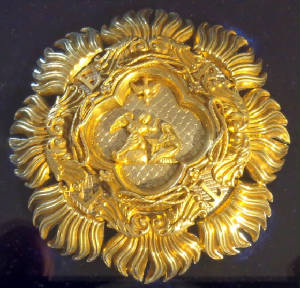
More Orders:
Chivalric and/or military orders that could qualify depending on definition. - Confraternity of Belchite,
"experimental" confraternity of knights founded in 1122 by King Alfonso the Battler of Aragon
- Order of Saint Blaise, founded in the 12th century in Armenia to defend the country
against the attacks of the Muslims
- Knights
of the Band, early honorific military order founded c. 1330 by King Alfonso XI of Castile
- Order of the Most Holy Annunciation, military order founded in 1350 by Duke Amadeus VI, Count of
Savoy, the first called the Order of the True Lover's Knots in memory of a bracelet of hair presented to the founder
by a lady, but upon the election of Amadeus VIII to the pontificate in 1439, it changed its
name for that of the Annunciation of angel Gabriel
- Order
of the Dove, short-lived (one year) and controversial order founded in 1379 by King Juan I of Castile
- Order of Saint Anthony (Bavaria), Bavarian military order founded in 1382 by Duke Albert
I, Duke of Bavaria
- Military Order of Cross-bearers with the Red
Star on a Blue Field, hospitaller and/military order active from the 12th century until suppressed
in 1656 by Pope Alexander VII.
- Order of Saint Hubert, early honorific
military order founded in 1444 or 1445 by Gerhard VII, Duke of Jülich-Berg
- Blood of Jesus Christ (military order), founded in Mantua, Italy, by Vincenzo I Gonzaga,
Duke of Mantua, approved on 25 May 1608 by Pope Paul V
- Order of the Knights of Concórdia, founded in 1246 by King Ferdinand III of Castile
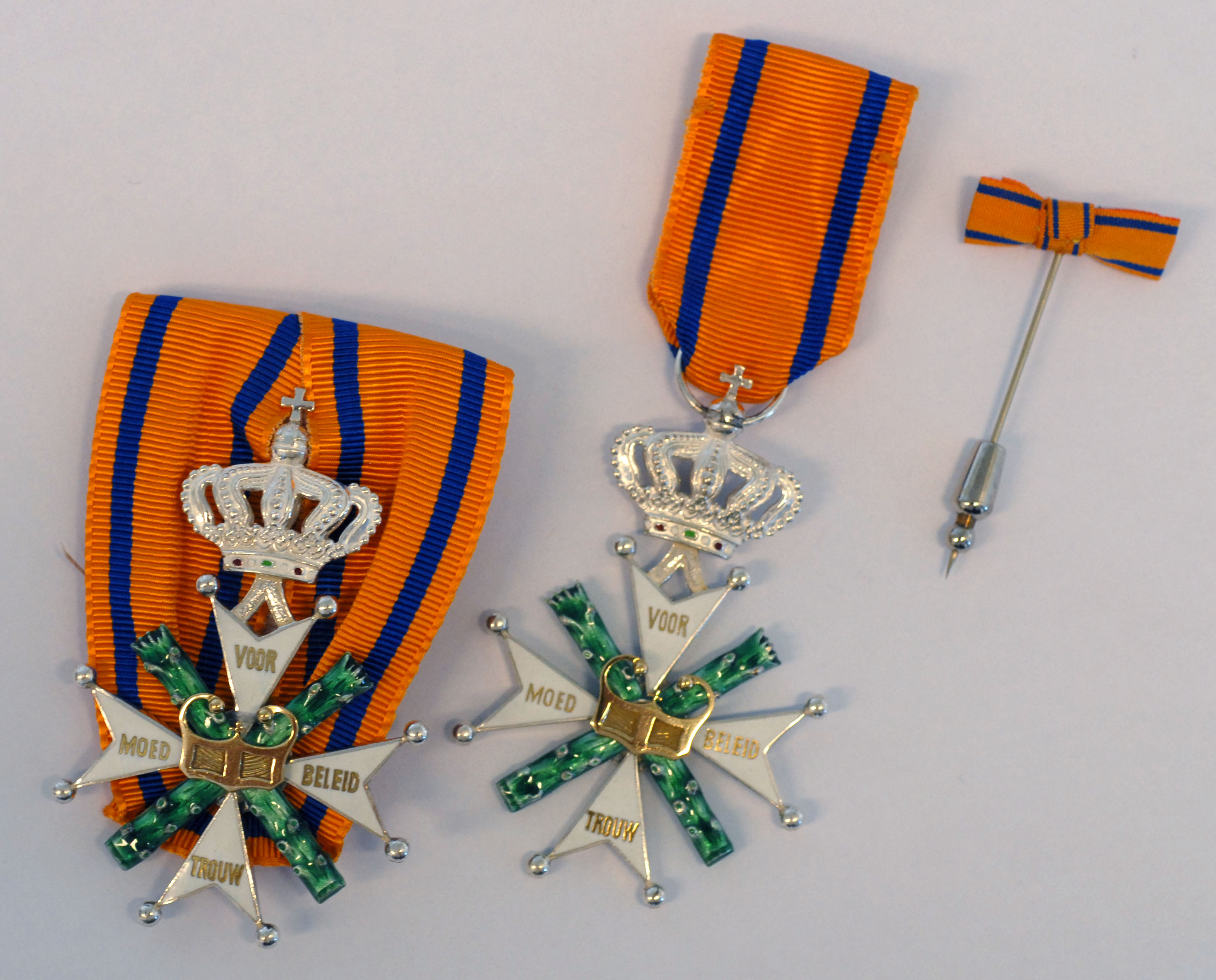
Modern development A few of the institutions survived into honorific and/or charitable
organizations, including the papal orders of knighthood. While other contemporary Catholic
societies may share some military organizational features and ideology, such as the Society of Jesus, they differ from the
medieval military orders in the absence of military purposes or potential. Modern orders may still be founded explicitly as
a military order; the Military Order of Loyalty (Spanish: Orden Militar de la Constancia) was founded in 1946 by
the Spanish protectorate in Morocco. Awarded to both Spanish and Moroccan military officers
and soldiers, the single-class order was abolished in 1956.
|

